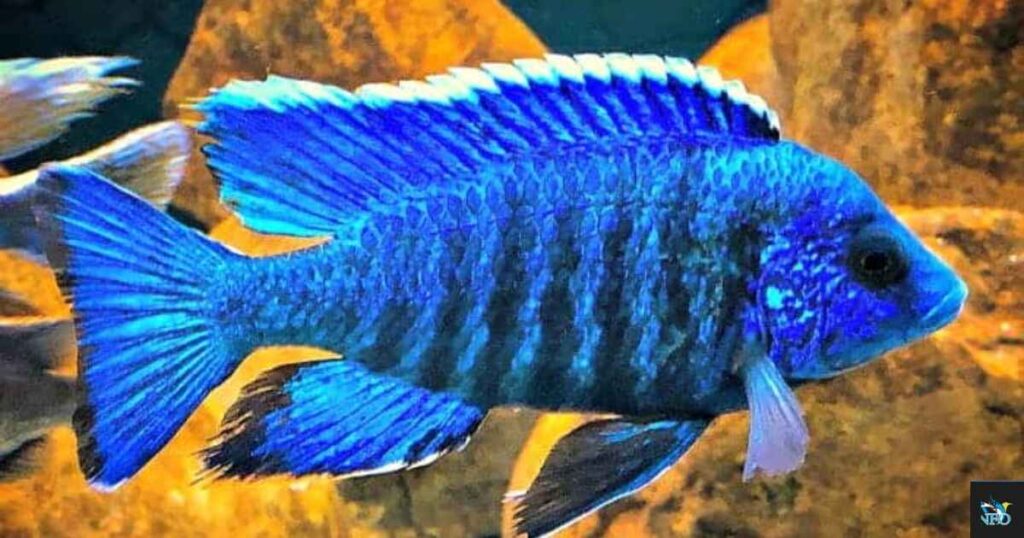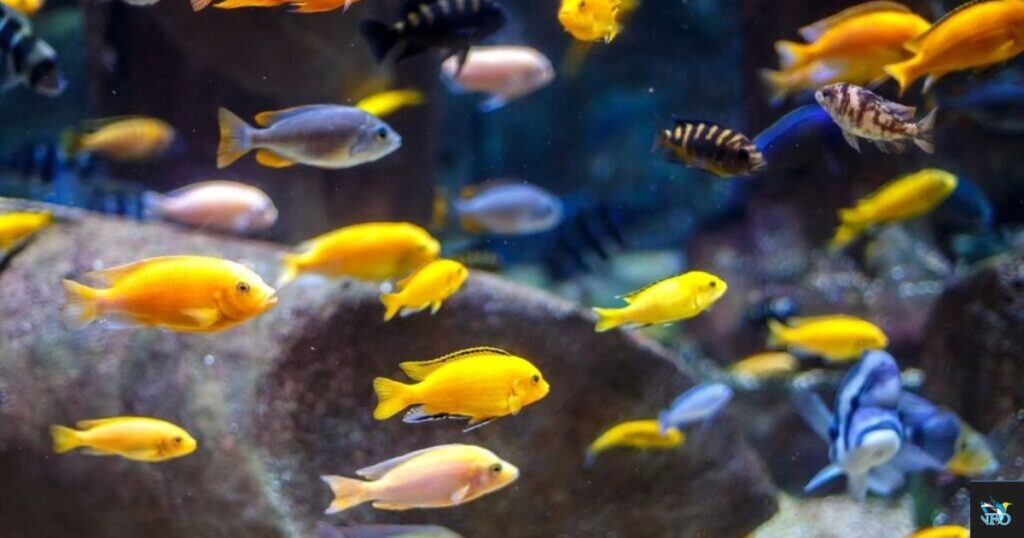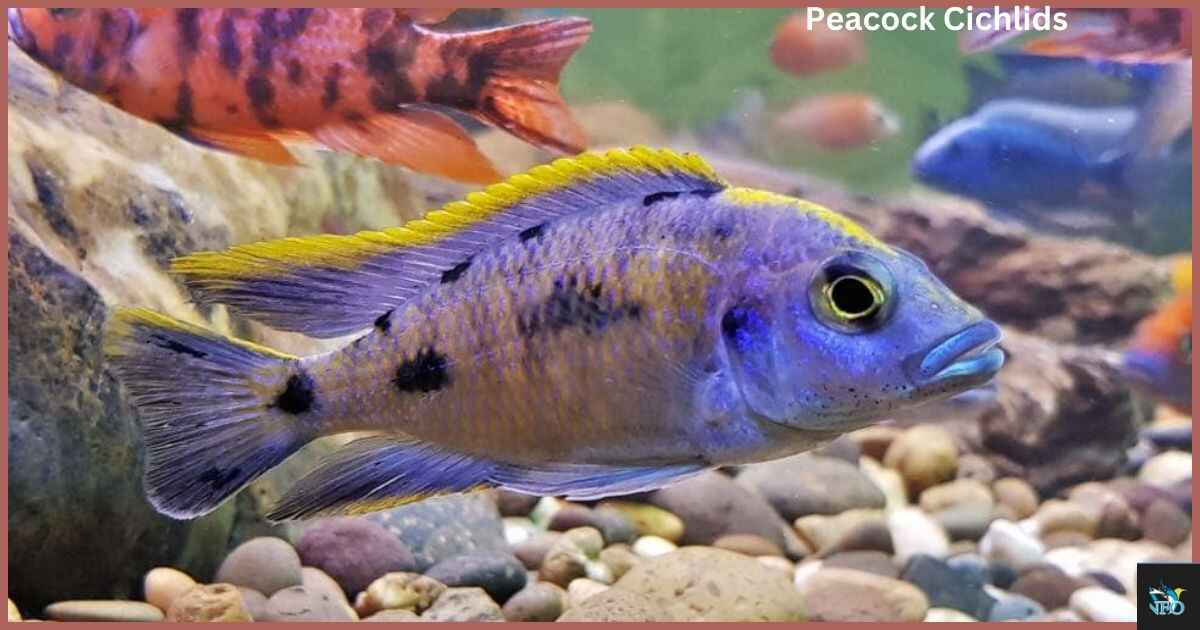Peacock Cichlids are the living jewels of the aquarium world, captivating fish enthusiasts with their dazzling array of vibrant hues and peaceful demeanor.
Native to the crystal-clear waters of Lake Malawi in Africa, these freshwater cichlids have become a favorite among aquarists for their striking beauty and relatively easy care requirements. Unlike some of their more aggressive African cichlid cousins, Peacocks are generally compatible with a variety of tank mates, making them ideal for community aquariums.
With proper care, including maintaining optimal water quality and providing a balanced diet, these colorful cichlids can thrive in captivity, growing to an average size of 3-4 inches and living up to 8-10 years. Whether you’re a seasoned aquarist or a beginner, Peacock Cichlids offer an exciting opportunity to create a stunning underwater display in your home.
Peacock Cichlid Overview

Peacock Cichlids, scientifically known as Aulonocara, are a group of colorful fish that hail from the crystal-clear waters of Lake Malawi in East Africa. These African cichlids have captured the hearts of aquarium enthusiasts worldwide with their striking colors and relatively peaceful nature. Unlike some of their more aggressive cichlid cousins, Peacocks are generally easier to keep in a community aquarium.
These fish are known for their intelligence and curious nature. They’ll often interact with their owners, making them a joy to watch and care for. Peacock Cichlids come in a rainbow of colors, from electric blues to fiery reds, making them a perfect choice for those who want to create a visually stunning aquarium.
Read This Blog:
Red Robin Bird Vs Cardinal: 16 Obvious Differences Between These Birds
Lifespan
When it comes to longevity, Peacock Cichlids can be your aquatic companions for quite some time. In a well-maintained aquarium with proper care, these vibrant fish typically live for 6 to 8 years. However, some lucky aquarists have reported their Peacocks living up to 10 years or more!
The key to maximizing your Peacock Cichlid’s life expectancy lies in providing them with optimal care. This includes maintaining excellent water quality, providing a balanced diet, and ensuring a stress-free environment. Regular water changes, a nutritious diet, and a spacious tank with plenty of hiding spots can go a long way in extending your fish’s lifespan.
Appearance: Types, Colors & Size
Peacock Cichlids are true to their name, boasting an array of colors that rival their avian namesakes. These fish typically grow to a length of 3 to 4 inches, with males being slightly larger and more colorful than females. Their bodies are elongated and laterally compressed, with long, flowing fins that add to their graceful appearance.
The real magic of Peacock Cichlids lies in their incredible colour variants. Here are some popular types you might encounter:
- OB Peacock: Known for their orange and blue spotted pattern
- Dragon Blood: Features a striking red colouration
- Sunshine: Boasts a vibrant yellow body with blue fins
- Blue Neon: Displays an electric blue hue that seems to glow
- Strawberry: Showcases a beautiful pinkish-red colouration
- Albino: Characterized by a pale body and red eyes
Remember, the intensity of these vibrant hues can vary based on factors like diet, water conditions, and the fish’s mood. A happy, healthy Peacock Cichlid will display the most vivid colours.
Behaviour
Peacock Cichlids are generally known for their peaceful temperament, especially when compared to other African cichlids. They’re active swimmers who love to explore their environment, often sifting through the substrate in search of food. This behaviour not only helps keep your tank clean but also provides endless entertainment for observers.
While they’re not overly aggressive, Peacocks can become territorial, especially during breeding season. Males may display territorial behaviour by chasing other males or showing off their colours to impress females. It’s important to provide enough space and hiding spots to minimize conflicts. Despite their occasional squabbles, Peacock Cichlids are social creatures that thrive in groups, making them excellent candidates for a well-planned community aquarium.
Tank Size and Environment
When it comes to housing Peacock Cichlids, bigger is definitely better. These active swimmers need plenty of space to thrive. For a small group of 4-6 Peacocks, you’ll want to start with a minimum tank size of 55 gallons. However, if you’re planning on keeping a larger group or want to create a more diverse community, aim for a 75-100 gallon tank or larger.
The shape of the tank matters too. Peacock Cichlids prefer tanks that are longer rather than taller, as this provides more swimming space and allows for the creation of multiple territories. A good rule of thumb is to provide at least 3 feet of tank length for every 5-6 adult Peacocks. Remember, a spacious environment not only keeps your fish happy but also helps reduce aggression and stress.
| Number of Peacock Cichlids | Minimum Tank Size |
| 1-3 | 30-40 gallons |
| 4-6 | 55-75 gallons |
| 7-10 | 100-125 gallons |
| 10+ | 150+ gallons |
Water Quality & Water Parameters
Maintaining optimal water quality is crucial for the health and vibrant coloration of your Peacock Cichlids. These fish are native to Lake Malawi, known for its clear, alkaline waters. To recreate these conditions in your aquarium, you’ll need to pay close attention to several key water parameters.
The ideal pH range for Peacock Cichlids is between 7.5 and 8.5, slightly alkaline. Water temperature should be maintained between 76°F and 82°F (24°C to 28°C). These fish prefer hard water, with a water hardness range of 10-15 dGH. Regular testing of these parameters is essential to ensure a stable environment. Invest in a good quality test kit and perform water tests at least once a week.
| Parameter | Ideal Range |
| pH | 7.5 – 8.5 |
| Temperature | 76°F – 82°F |
| Water Hardness | 10 – 15 dGH |
| Ammonia | 0 ppm |
| Nitrite | 0 ppm |
| Nitrate | < 20 ppm |
Peacock Cichlid Diet

Peacock Cichlids are omnivorous, which means they enjoy a varied diet in the wild. In your aquarium, it’s important to replicate this diversity to ensure your fish receive all the necessary nutrients. A high-quality diet not only keeps your Peacocks healthy but also enhances their vibrant colors.
The foundation of their diet should be a good quality cichlid flake or pellet food. These are specially formulated to meet the nutritional needs of cichlids. Supplement this with frozen or live foods such as brine shrimp, bloodworms, and daphnia. Peacocks also enjoy some vegetable matter, so don’t forget to offer them blanched spinach or zucchini occasionally. Feed your Peacocks small amounts 2-3 times a day, only as much as they can consume in about 2-3 minutes.
Breeding
Breeding Peacock Cichlids can be a fascinating and rewarding experience. These fish are mouthbrooders, which means the female carries the eggs and fry in her mouth until they’re ready to swim on their own. The breeding process involves several stages, from courtship to the release of fry.
Step 1: Separate the Breeding Pairs Into a Different Tank
To start the breeding process, set up a separate breeding tank of at least 30 gallons. This tank should have plenty of hiding spots and a sandy substrate for egg laying. Choose a healthy, mature pair of Peacocks – the male should be at least 3 inches long and the female about 2.5 inches. Raise the water temperature slightly to about 82°F (28°C) to encourage breeding behavior.
Step 2: Breeding Starts in The Tank
Once in the breeding tank, the male will begin to display his vibrant colors to attract the female. He’ll perform a courtship dance, shimmying and shaking near the female. If she’s receptive, she’ll follow him to his chosen spawning site. The female will lay her eggs, usually on a flat surface, and the male will immediately fertilize them. Then, in a fascinating display of maternal care, the female will scoop all the eggs into her mouth for protection.
Step 3: Put the Babies in The Main Tank
The female will carry the eggs in her mouth for about 18-21 days. During this time, she may not eat, so it’s important not to disturb her. Once the fry are released, they’re usually large enough to avoid being eaten by adult fish. However, for maximum survival rate, you can move the fry to a separate rearing tank. Feed them finely crushed flakes or specially formulated fry food. After about 6-8 weeks, when they’re about an inch long, you can introduce them to the main tank.
Features of Peacock Cichlids:
Peacock Cichlids are truly unique fish with several standout features that make them a favorite among aquarium enthusiasts. Their most striking feature is undoubtedly their vibrant coloration, which can range from deep blues and purples to bright yellows and reds. This rainbow of colors is especially pronounced in males, who use their dazzling hues to attract mates and establish dominance.
Another notable feature of Peacock Cichlids is their relatively peaceful nature compared to other African cichlids. This makes them excellent candidates for community tanks, provided their tank mates are chosen carefully. They’re also known for their intelligence and curious nature, often interacting with their owners and showing individual personalities.
The Best Aquarium Size for Cichlid:
When it comes to housing Peacock Cichlids, the adage “bigger is better” certainly applies. These active swimmers need plenty of space to thrive and display their natural behaviors. For a small group of 4-6 Peacocks, a minimum tank size of 55 gallons is recommended. However, if you’re planning on keeping a larger group or creating a more diverse community, you should aim for a 75-100 gallon tank or even larger.
The shape of the tank is also important. Peacock Cichlids prefer tanks that are longer rather than taller, as this provides more swimming space and allows for the creation of multiple territories. A good rule of thumb is to provide at least 3 feet of tank length for every 5-6 adult Peacocks. Remember, a spacious environment not only keeps your fish happy but also helps reduce aggression and stress.
Tank Mate Compatibility:

While Peacock Cichlids are generally peaceful, it’s important to choose their tank mates carefully to ensure a harmonious community. Ideal tank mates should be similar in size and temperament to the Peacocks. Here are some compatible fish species that can coexist well with Peacock Cichlids:
- Other peaceful Malawi cichlids (e.g., Yellow Labs, Acei)
- Synodontis catfish
- Rainbowfish
- Larger tetras (e.g., Congo Tetras)
- Peaceful Loaches (e.g., Clown Loaches)
Avoid housing Peacock Cichlids with very aggressive species or much smaller fish that could be seen as food. Also, be cautious about mixing different species of Peacocks, as males may cross-breed, leading to hybrid offspring.
Feeding:
A balanced and varied diet is crucial for maintaining the health and vibrant colors of your Peacock Cichlids. In the wild, these fish are omnivores, feeding on small invertebrates, algae, and plant matter. In your aquarium, you should aim to replicate this diverse diet.
The foundation of their diet should be a high-quality cichlid flake or pellet food. These are specially formulated to meet the nutritional needs of cichlids. Look for foods that are high in protein and contain color-enhancing ingredients. Supplement this staple diet with frozen or live foods such as brine shrimp, bloodworms, and daphnia. These protein-rich treats are not only nutritious but also stimulate natural feeding behaviors.
Don’t forget to include some vegetable matter in their diet. Blanched spinach, zucchini, or cucumber can be offered occasionally. Some aquarists also use specialized veggie clips to hold these vegetables in place, making it easier for the fish to graze.
Feed your Peacocks small amounts 2-3 times a day, only as much as they can consume in about 2-3 minutes. Overfeeding can lead to water quality issues and health problems for your fish.
Also Read This Blog:
What Do Red Robins Symbolize: Spiritual And Symbolic Explorations
Peacock Cichlid Fish Tank Setup:
Creating the perfect habitat for your Peacock Cichlids involves more than just filling a tank with water. A well-designed setup will not only keep your fish healthy but also showcase their beautiful colors. Here’s a breakdown of the key elements you’ll need to consider:
Aquarium Filtration
Efficient filtration is crucial for maintaining good water quality in your Peacock Cichlid tank. These fish produce a fair amount of waste, so a robust filtration system is necessary. Canister filters are often recommended for cichlid tanks due to their high capacity and efficiency. Aim for a filter that can process the entire volume of your tank at least 4-6 times per hour.
Heater
Peacock Cichlids are tropical fish that require warm water to thrive. A reliable heater is essential to maintain a stable temperature between 76°F and 82°F (24°C to 28°C). Choose a heater with enough wattage for your tank size, and consider using two smaller heaters instead of one large one for better temperature distribution and as a backup in case one fails.
Lighting
While Peacock Cichlids don’t have specific lighting requirements, good tank illumination can really make their colors pop. LED lights are an excellent choice as they’re energy-efficient and can often be adjusted to create different effects. A lighting period of 8-10 hours per day is typically sufficient.
Plants for Cichlid
While Peacock Cichlids aren’t known for being plant-friendly, some hardy species can survive in their tanks. Anubias, Java Fern, and Vallisneria are good choices as they’re tough and can withstand some nibbling. Artificial plants are also an option if you want the look of a planted tank without the maintenance.
Decorations for Cichlid
Decorations play a crucial role in creating a comfortable environment for your Peacock Cichlids. Rocks, caves, and driftwood not only provide hiding spots but also help establish territories, which is important for reducing aggression. Arrange these decorations to create line-of-sight breaks, allowing fish to retreat from aggressive tankmates.
Substrate
A sandy substrate is ideal for Peacock Cichlids, as it mimics their natural habitat in Lake Malawi. Fine, smooth sand allows them to sift through it naturally, looking for food particles. Avoid sharp or rough substrates that could injure the fish as they dig.
Conclusion
Peacock Cichlids are truly a marvel of the aquatic world, bringing a rainbow of colors and fascinating behaviors to any freshwater aquarium. These African cichlids from Lake Malawi offer aquarists a unique blend of beauty and relatively peaceful temperament, making them an excellent choice for both experienced hobbyists and dedicated beginners.
Success with Peacocks hinges on providing a spacious fish habitat with optimal water parameters, a varied omnivorous diet, and carefully selected compatible fish as tank mates. With proper care, including regular water changes and maintenance of filtration equipment, these vibrant hues can flourish in your community tank for years to come.
Whether you’re drawn to the electric blue of a Neon Peacock or the fiery red of a Dragon Blood, there’s a Peacock Cichlid variety to capture every aquarist’s heart. By recreating a slice of Lake Malawi in your home, you’ll not only have a stunning display but also gain insight into the fascinating world of these colorful cichlids.
FAQs
How aggressive are peacock cichlids?
Peacock cichlids show moderate aggression, especially during breeding, but are generally peaceful with proper tank conditions.
How big do peacock cichlids get?
They typically grow to 4-6 inches (10-15 cm), with some larger males reaching up to 7-8 inches (18-20 cm).
How many peacock cichlids should be kept together?
In larger tanks, you can keep 5-10 peacock cichlids, ensuring ample space and hiding spots to minimize aggression.
What fish can I mix with peacock cichlids?
Compatible tank mates include other peaceful cichlids, loaches, catfish, and red tail sharks.

Welcom to https://birdsaboutinfo.com. Our content is for general information purposes. While we aim for accuracy, use it at your own risk. Seek professional advice for specific concerns. We’re not responsible for external links or the outcome of using our information. Some content may contain affiliate links. We may update this Disclaimer.











